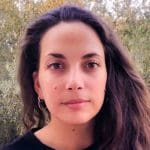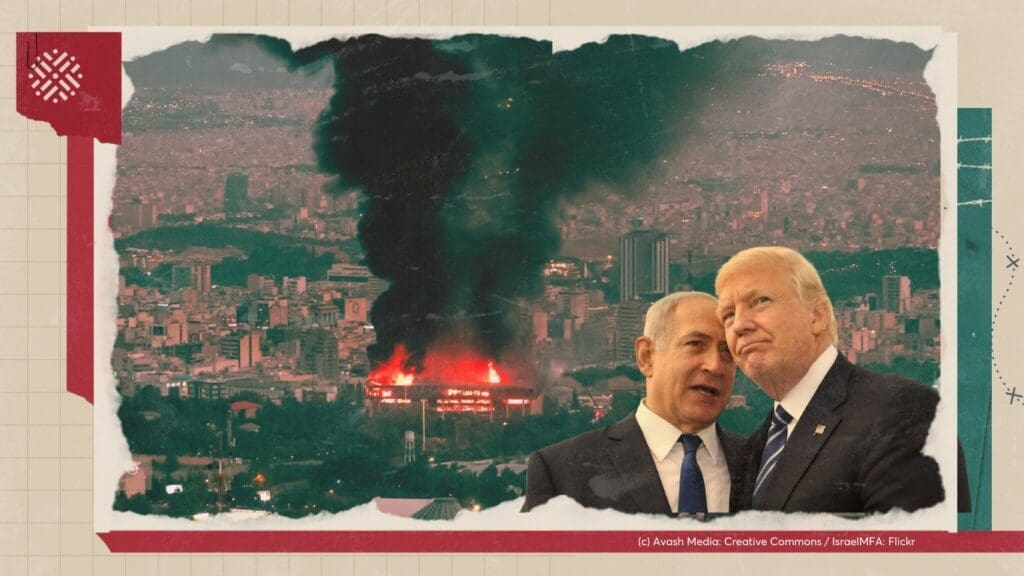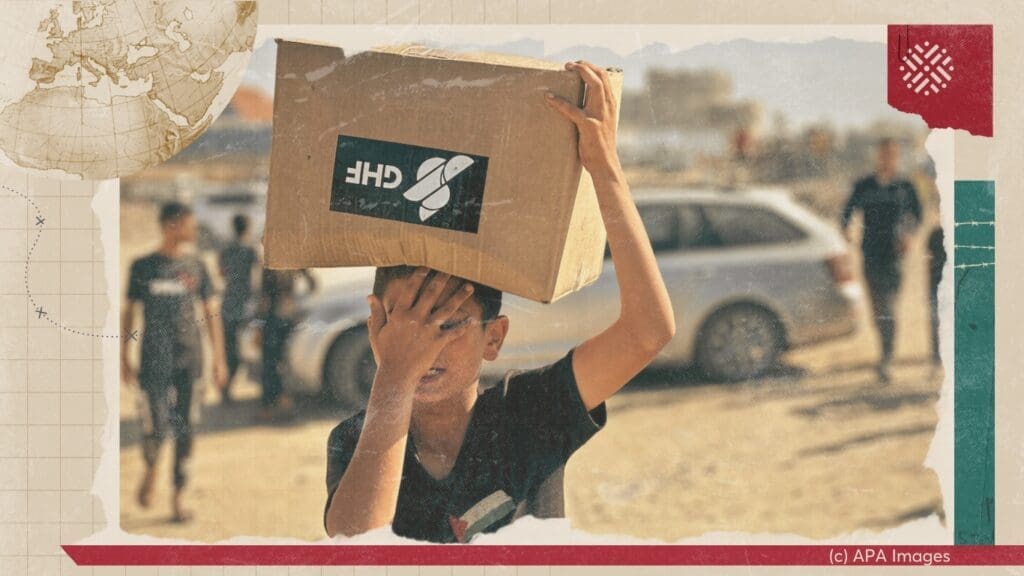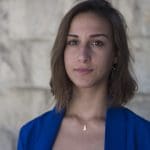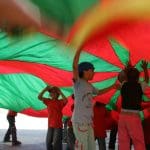
Executive Summary
The significant discursive shift that emerged globally following the 2021 Unity Intifada successfully centered Zionist settler colonialism as the root cause of the Palestinian struggle. This policy brief explores how Palestinians can rethink their liberation struggle by turning to their rich history of popular mobilization. It examines the successes of the Palestinian popular committees that formed in the West Bank and Gaza throughout the 1970s and 1980s, and offers recommendations for how Palestinian civil society today can work to rebuild communities that facilitate the development of a reimagined grassroots liberationist movement.
The First Intifada built on grassroots missions and practices aimed at disengaging from Israeli settler colonialism that had been part of Palestinian society for nearly two decades. Indeed, the national campaigns that emerged during the Intifada included the boycott of Israeli products and of the Israeli Civil Administration, refusal to pay Israeli taxes, and successful calls for the resignation of hundreds of Palestinian tax collectors and police officers—all tactics practiced throughout the 1970s and 1980s.
In the early 1970s, Palestinian volunteer movements formed across the West Bank and Gaza to mitigate the suffering of communities most directly affected by Israel’s 1967 military occupation. Before long, these movements grew into regional networks of volunteers whose activities politicized a generation of youth by bringing different parts of Palestinian society together and developing awareness of the importance of anti-colonial struggle.
The networks also led to the rise of popular committees which responded to Israel’s neglect and de-development in various sectors of Palestinian life. The most ubiquitous popular committees worked at the neighborhood level, and were usually composed of local youth. They mainly provided support to the most vulnerable and increased the resilience of communities in the face of Israeli attacks, including through coordinating mutual aid, carrying out nightly guard duty to alert of settler and military attacks, and organizing the storage and distribution of food for prolonged curfews.
Networks of cooperatives and home economy projects also promoted local produce and aimed to reduce the reliance on Israeli goods. Many neighborhoods also undertook backyard farming to increase food security. These committees contributed significantly to the mobilization witnessed among farmers during the First Intifada, ensuring an expanding network of anti-colonial, liberationist Palestinian farmers and agronomists.
Similarly, Palestinians formed health committees composed of volunteer healthcare professionals who provided medical services in rural areas. Many of these committees adopted a liberationist conceptualization of health, promoting holistic treatment that centered social, political, and economic determinants. The health committees were so fundamental to Palestinian civil society, political groups were compelled to form and promote them. Indeed, health committees were so successful at reaching Palestinians at the grassroots level, they permeated the Palestinian political spectrum, and between them were providing 60% of primary healthcare and all disability services in the West Bank and Gaza by 1993.
But following the devastating First Intifada, the PLO's adoption of the Oslo framework in 1993, and the subsequent formation of the Palestinian Authority (PA) in 1994, a process of depoliticization replaced the liberationist framework of the committees and cemented a shift in discourse from liberation to state-building. Throughout the 1990s, several popular committees formalized into non-governmental organizations (NGOs), and many committee members, including leftist activists, joined the post-Oslo NGO world, while some popular committees registered as charities and adapted to the neoliberalization of Palestinian civil society.
In addition to the domination of a state-centered discourse, Israel’s ongoing destruction and fragmentation of Palestinian communities continues to hinder Palestinians’ ability to organize. The complicity of the PA in perpetuating this status quo also places significant obstacles on Palestinians’ ability to mobilize as they did in the 1970s and 1980s. And while examining the successes of the popular committees will not automatically lead to a clear vision for liberation today, they can inform initial goals to facilitate the growth of a reimagined liberation framework among Palestinians.
While challenges and obstacles will remain, Palestinian civil society must:
- Reorient municipal councils’ priorities to revive their political and social roles, including ensuring sustainable infrastructure in rapidly-growing towns and cities.
- Strengthen the role of cultural and educational institutions, public libraries, and other public forums to provide spaces through which communities can articulate political needs and demands. Universities should complement this by expanding their engagement with the public.
- Redirect professional services towards addressing the holistic needs of the communities they serve rather than applying neoliberal frameworks in the public sector.
- Promote existing popular movements that have already formed community-based structures, such as in Beita, Sheikh Jarrah, Silwan, Umm al-Fahm, and the Naqab, and that are well-placed to expand their role from reactive organizing to articulating a vision for liberation from their communal bases.
Introduction
With the significant discursive shift that emerged globally following the 2021 Unity Intifada, Palestinians and their allies successfully centered Zionist settler colonialism as the root cause of their struggle, with liberation as the only solution. This has supplanted the peace and state-building narratives that have dominated global discourse on Palestine, especially since the 1993 Oslo Accords. The ongoing Unity Intifada continues to challenge the forced geographical, social, and political fragmentation of the Palestinian people, thereby aligning the struggles and hopes of Palestinian communities worldwide.1
Advancing the goal of liberation requires the redevelopment of an anti-colonial framework. In addition to promoting a liberationist discourse, the framework necessitates subverting the colonial structures under which Palestinians live. This policy brief explores how Palestinians can rethink their liberation struggle by turning to their rich history of popular mobilization. Specifically, it examines the successes of the Palestinian popular committees that formed in the West Bank and Gaza throughout the 1970s and 1980s, and offers recommendations for how civil society today can work to rebuild communities that facilitate the development of a reimagined grassroots liberationist movement.
The Legacy of Palestinian Popular Committees
The impressive national mobilization by Palestinians in the First Intifada should be seen in the context of the popular mobilization that preceded it. The First Intifada built on grassroots missions and practices aimed at disengaging from Israeli settler colonialism. The national campaigns that emerged during the Intifada, often coordinated by the United Leadership of the Uprising (UNLU), included the boycott of Israeli products and of the Israeli Civil Administration, refusal to pay Israeli taxes, and successful calls for the resignation of hundreds of Palestinian tax collectors and police officers—all tactics practiced throughout the 1970s and 1980s.
The national campaigns and the popular committees’ efforts to defy the Israeli occupation apparatus were mutually reinforcing, and Israel’s eventual banning of all popular committees in 1988 illustrates their success. Indeed, Israel’s defense minister at the time commented that the decision to ban popular committees was due to their “undermining the Israeli government apparatus and establishing an alternative apparatus in its place.”
Palestinian Volunteerism in the Service of Liberation
Palestinian volunteer movements formed across the West Bank and Gaza at a time when the struggle for liberation was being replaced with a state-building project. While this project was confirmed in the years following the signing of the 1993 Oslo Accords, the Palestine Liberation Organization (PLO) arguably adopted this model as early as 1974 when it approved the 10-point program, a proposal which introduced the concept of the two-state solution to Palestinian nationalist discourse. Although backed by Fatah, the largest Palestinian faction within the PLO, this program was condemned by other factions that formed the Rejectionist Front on the basis that Fatah was forsaking the remainder of historic Palestine.
Palestinian civil society also condemned the program and, starting in the 1970s, organized voluntary movements to mitigate the suffering of communities that fell under Israeli occupation after 1967. Mainly composed of middle-class professionals, the volunteers assisted farmers and poorer communities most directly impacted by the military occupation, and adopted projects to fix destroyed infrastructure. Before long, they grew into regional networks of volunteers, some of which belonged to political parties, including Fatah and the Jordanian Communist Party.2
The First Intifada built on existing missions and practices aimed at disengaging from Israeli settler colonialism Share on X
The activities of the volunteer networks politicized a generation of youth by bringing different parts of Palestinian society together and developing awareness of the importance of anti-colonial struggle. These networks grew in conjunction with cultural institutions that asserted Palestinian identity and history. For example, El-Funoun Palestinian Popular Dance Troupe was established in 1979 with the mission to assert Palestinian political and cultural identity. In 1972, In’ash al-Usra Society, a non-profit feminist and developmental organization founded in 1965, began a cultural program to preserve and revitalize Palestinian heritage.
These growing networks facilitated political successes and instilled an anti-colonial ethos to resisting Israeli military aggression. In 1976, Palestinians elected a large number of progressive mayors and municipal councils. This enabled the establishment of the National Guidance Committee in 1978, which was made up of mayors, union representatives, student activists, and other grassroots organizers. Groups such as this accelerated the organization of politically active alliances across the occupied territories, which encouraged and normalized grassroots mobilization in public institutions and on the Palestinian street as a means to challenge settler-colonial military occupation.
For example, months-long protests in 1979 led to the evacuation of the Elon-Moreh Israeli settlement, which had been built on private land belonging to Palestinian residents of the town of Rujeib. The same year, protests and the mass resignation of mayors prevented Israel’s deportation of the mayor of Nablus. The municipal councils elected in 1976 likewise managed to reduce their financial reliance on Israeli funding sources, instead raising funds from neighboring Arab countries to expand municipal services. This was particularly successful in Nablus, where the city was able to increase its independence in the energy sector.
Israel’s initial attempts to stifle this movement included the criminalization of members’ activities and restricting the movement of many mayors and activists. Palestinian universities, many of which were hubs for political activity, were shut for several months at a time from 1979 and into the 1980s. In 1980, underground Israeli militias attempted to assassinate three West Bank mayors, seriously injuring two of them. The extent to which Israeli occupation authorities suppressed Palestinian grassroots activism throughout this period attests to its political clout and efficacy.
In 1982, Israel outlawed the National Guidance Committee and removed the elected municipal councils and mayors from office. It replaced them with less confrontational figures, and in some areas handed over municipal functions to Village Leagues. These leagues were largely composed of Palestinians from rural communities throughout the West Bank who were willing to collaborate with Israel in exchange for services, arms, and financial support. Although the Village Leagues ultimately failed due to Palestinian popular resistance, they represented the first Israeli iteration of Palestinian self-administration.
The Rise of the Popular Committees
The movement of volunteers led to the rise of popular committees in the 1970s and 1980s. These committees shared the aim of addressing the gaps left by Israel’s neglect and de-development in various sectors and were deliberately rooted in the communities which they served.
Popular committees were established throughout the West Bank and Gaza, fulfilling a variety of functions. The most ubiquitous popular committees worked at the neighborhood level, and were usually composed of local youth. They mainly provided support to the most vulnerable and increased the resilience of communities in the face of Israeli attacks, including through coordinating mutual aid, carrying out nightly guard duty to alert of settler and military attacks, and organizing the storage and distribution of food for prolonged curfews. During the First Intifada, when the Israeli military forced months-long school closures, popular committees also established their own schools, often in places of worship or even in people’s driveways.
Most popular committees relied on the mobilization of volunteers. They therefore generally ran low budgets, which were primarily raised through local contributions and nominal fees. Professionalized committees, such as the agricultural and health committees, were more likely to seek additional external funding from western donors, while Arab donors generally funded institutions based in cities, such as Islamic charities. The expanding network of funding signified a substantive and promising Palestinian grassroots movement.
Economic and Agricultural Committees
A central goal of the popular committees was to promote the independence of the Palestinian economy. Networks of cooperatives and home economy projects promoted local produce and aimed to reduce the reliance on Israeli goods. Many neighborhoods also undertook backyard farming to increase food security. Such initiatives were particularly prevalent during the First Intifada, when the commitment to boycotting the Israeli economy was at its peak.
The PLO's adoption of the Oslo framework in 1993 … accelerated a process of depoliticization … cementing a shift in discourse from liberation to state-building Share on X
Agricultural collectives formed on the national level by networks of agronomists and activists aiming to protect and develop the declining sector. Farmers frequently faced land confiscation and damage to infrastructure by Israeli occupation forces, threatening their livelihoods and increasing Palestinians’ reliance on the Israeli economy. In response, networks of volunteers assisted with farm work, organized to protect farmers, and funded infrastructure development.
Many of these voluntary efforts developed into popular committees in the 1980s. For example, the Palestinian Agricultural Relief Committee (PARC)3 was established in 1983, followed by the Union of Agricultural Work Committee and the Technical Center for Agricultural Services in 1986. These committees contributed significantly to the mobilization witnessed among farmers during the First Intifada, ensuring an expanding network of anti-colonial, liberationist Palestinian farmers and agronomists.
Health Committees
Similarly, Palestinians formed health committees composed of volunteer healthcare professionals who provided medical services in rural areas. While their primary goal was to counter Israeli occupation policies that put Palestinians’ health at risk, they also challenged the paternalistic and elitist attitudes and practices of the Palestinian medical establishment, which were perceived as additional risk factors.
The Palestinian medical elite attempted to establish institutions that were autonomous from Israel, but failed to confront Israeli authorities and, instead, focused on expanding specialized medical services in city centers and retaining paternalistic attitudes in service delivery. Healthcare was therefore framed as an individualistic issue rather than a community one, contributing to the neglect of marginalized groups. Consequently, many younger professionals came to reject not only colonial rule, but also the Palestinian medical establishment.
Many health committees thus adopted a liberationist conceptualization of health, promoting holistic treatment that centered social, political, and economic determinants. These committees focused on health promotion and public health, providing primary care to underserved communities and flouting the traditional medical establishment by engaging recipients of healthcare in the planning and delivery of the services they needed.
The anti-colonial foundations of many of the popular committees are also highlighted by their links to other liberation movements and international solidarity campaigns. For example, the founders of the Union of Palestinian Medical Relief Committees (UPMRC)4 also co-founded the International People’s Health Council, which brought together health professionals involved in social justice movements in countries like South Africa, Nicaragua, and Bangladesh.
Although health committees were independent organizations, each was founded by a group of professionals with ties to political parties. Indeed, the health committees were considered to be so fundamental to Palestinian civil society, political groups were compelled to form and promote them. The first and largest of these was the UPMRC, established in 1979 by professionals with ties to the Communist Party. This was followed by the Union of Health Care Committees in 1984, tied to the Democratic Front for the Liberation of Palestine, and the Union of Health Work Committees in 19855, with connections to the Popular Front for the Liberation of Palestine.
But not all health committees espoused anti-colonial agendas. In 1989, Fatah-affiliated professionals established the Health Services Council (HSC). The HSC adopted the same reformist approach of its affiliate and was thus perceived to lack a clear liberationist vision. As a result, while left-wing committees worked in open defiance of Israeli authorities, HSC presented itself as a charity and registered with the Israeli government as a nonprofit association. From its inception, HSC thus reverted to the traditional medical establishment’s focus on paternalistic, centralized services in urban centers, while the leftist committees reached out to underserved communities and aimed to empower them through education, preventive medicine, and health promotion programs.
Health committees were so successful at reaching Palestinians at the grassroots level, they permeated the Palestinian political spectrum, and between them were providing 60% of primary healthcare and all disability services in the West Bank and Gaza by 1993. However, the different political affiliations of popular committees sometimes led to them competing and duplicating services.
From Liberation to State-Building
While Israel banned the popular committees in 1988, they continued to function until several factors contributed to their collapse in the 1990s, including the tremendous physical and economic losses endured throughout the First Intifada. Moreover, the PLO’s adoption of the Oslo framework in 1993, and the subsequent formation of the Palestinian Authority (PA) in 1994, accelerated a process of depoliticization within Palestinian society, cementing a shift in discourse from liberation to state-building. The HSC, for example, integrated all its services and facilities into the newly-formed PA Ministry of Health and its director became the Deputy Health Minister.
After Oslo, many community-based and grassroots efforts, including some popular committees, formalized into non-governmental organizations (NGOs). This resulted in the creation of an expanding NGO sector that, along with the PA, competed for resources and “NGOized” the Palestinian liberation movement. Many members of the committees, including leftist activists, joined the post-Oslo NGO world, while some popular committees registered as charities and adapted to the neoliberalization of Palestinian civil society. The UNLU and popular committees’ lack of a clear political vision, beyond challenging the occupation, may have also increased their vulnerability to the neoliberalization project.
It is crucial to start by remedying the decimation of Palestinian communities, from which a liberation framework can develop and draw strength Share on X
Popular committees additionally suffered from the repercussions of various regional geopolitical developments the late 1980s and early 1990s. With its disengagement from the West Bank in 1988, Jordan announced the cessation of a $1.3 billion development program for the West Bank. Moreover, the exodus of Palestinians from Kuwait in the wake of the PLO’s support for Iraq during the Gulf crisis of 1990-91 cut the flow of remittances from hundreds of thousands of Palestinian workers previously based there. Although these had not been direct sources of funding for popular committees, they cut off a flow of income and capital into the West Bank. In addition, western governments politically invested in the Oslo process began redirecting funding from the new Palestinian NGOs to the PA. These factors contributed to the collapse of the liberation framework of the popular committees, gradually transforming into the state-building framework of the PA.
In addition to losing funding and political backing, popular committees lost personnel to the PA. The Ministry of Health staff increased from 2,000 in 1994 to 7,000 in 1999, and it is estimated that 70% of non-governmental primary health clinics shut down with the arrival of the PA. Moreover, the new NGOs became vulnerable to the conditions imposed by donors, where continued funding was tied to their depoliticization and acceptance of the Oslo Accords.
Ultimately, the losses inflicted upon Palestinians during the First Intifada, in conjunction with the state-building project institutionalized with the signing of the Oslo Accords, resulted in the dissolution of the popular committees as anti-colonial, liberationist movements, and in the proliferation of state-centered NGOs.
Obstacles to a Resurgence of Popular Organizing
The destruction of Palestinian communities by decades of settler-colonial occupation continues to hinder Palestinians’ ability to organize. Indeed, Israel has fragmented the Palestinian polity, with rapid urbanization exacerbating this problem. While only 35% of Palestinians in the West Bank and Gaza lived in urban areas in 1946, the percentage rose to 75% in 2020. This growth was driven by Israel’s policies of dispossession, which have disproportionately impacted rural areas. Moreover, with Israel’s ongoing ethnic cleansing, brutal violence, labor and resource exploitation, and with its policies to ensure Palestinian economic dependence persist, the possibility for substantive mobilization seems fleeting.
The complicity of the PA in perpetuating this status quo also places significant obstacles on Palestinians’ ability to mobilize as they did in the 1970s and 1980s. Beyond security collaboration with Israeli occupation forces, the PA is involved in the ongoing de-development of public services, including health and education. Poor urban planning in fragmented communities also means that Palestinians live in overcrowded urban spaces with limited provision of services. That is, the inability of Palestinians in these spaces to attain basic resources restricts their capacity to organize. Moreover, municipal councils, which have been effectively depoliticized, lack the expertise or the political will to address these challenges; their roles have been reduced to providing only the most basic services, such as utilities, waste disposal, and roads.
This is not to deny, however, that Palestinians have successfully organized in recent years in spite of these conditions. This includes localized protests in Jerusalem, Beita, Nabi Saleh, and other villages, the anti-Prawer protests in 2013, the movement against the conscription of the Druze community, the Great March of Return in 2018, the Tal’at movement – which articulated a feminist framework for liberation and organized protests across colonized Palestine and the region – and the ongoing Unity Intifada which began in May 2021.
Protests against PA corruption and its collaboration with Israel are also increasingly commonplace, the most significant of which occurred in the summer of 2021 against the PA forces’ assassination of prominent PA critic, Nizar Banat. Even universities have faced oppression by PA forces stifling political dissent on campuses. For example, in early 2022, the PA, backed by the student arm of Fatah, attacked Birzeit University for its students’ political activism. However, these efforts have been unable to mobilize into a broader liberationist movement, most notably due to systemic oppression by PA and Israeli forces.
Recommendations
While examining the successes of the popular committees of the 1970s and 1980s will not automatically lead to a clear vision for liberation today, they can inform initial goals to facilitate the growth of a reimagined liberation framework among Palestinians. It is crucial to start by remedying the decimation of Palestinian communities, from which a liberation framework can develop and draw strength.
While challenges and obstacles will remain, Palestinian civil society must:
- Reorient municipal councils’ priorities to revive their political and social roles, including ensuring sustainable infrastructure in rapidly-growing towns and cities to fulfill people’s social, cultural, and economic needs.
- Strengthen the role of cultural and educational institutions, public libraries, and other public forums to provide spaces through which communities can articulate political needs and demands. Universities should complement this by expanding their engagement with the public. In different university departments, educators should include programs in their curricula to ensure that their work is tied to surrounding communities. Moreover, universities should institutionalize and require colonial and anti-colonial studies across their student bodies.
- Redirect professional services towards addressing the holistic needs of the communities they serve rather than applying neoliberal frameworks in the public sector. For example, health professionals should reject individualistic and paternalistic healthcare practices and speak out about the necessity for improving the social, economic, and political determinants of health in order to promote communal wellbeing.
- Promote existing popular movements that have already formed community-based structures, such as in Beita, Sheikh Jarrah, Silwan, Umm al-Fahm, and the Naqab, and that are well-placed to expand their role from reactive organizing to articulating a vision for liberation from their communal bases. Civil society groups, unions, and other professional organizations must join in these movements and act as vehicles through which advocacy and campaigning can take place.
- To read this piece in French or Spanish, please click here or here, respectively. Al-Shabaka is grateful for the efforts by human rights advocates to translate its pieces, but is not responsible for any change in meaning.
- The Jordanian Communist Party was re-established in 1982 as the Palestinian Communist Party, and, in 1991, as the Palestinian People’s Party.
- PARC is known today as the Agricultural Development Association.
- UPMRC is known today as the Palestinian Medical Relief Society.
- The Union of Health Work Committees retained its name in Gaza, but is known today as the Health Work Committees in the West Bank.
